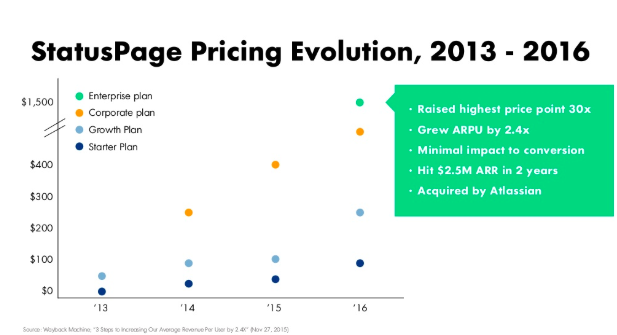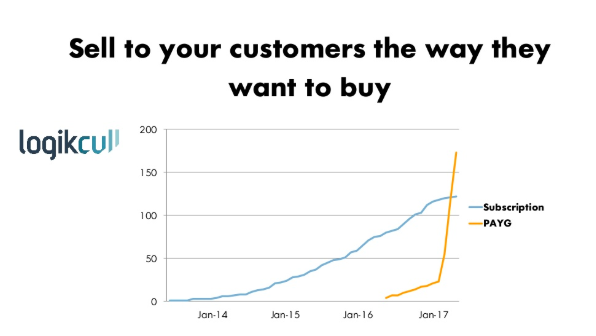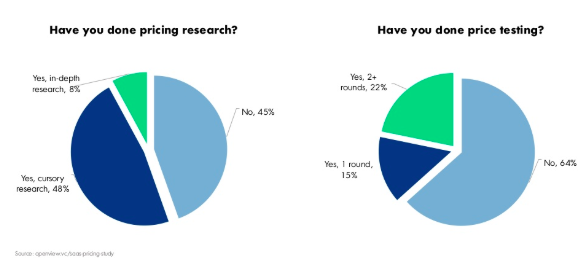
Recently, OpenView Venture Partners pricing experts, Partner Blake Bartlett and Senior Director of Market Strategy Kyle Poyar, joined host and CodeScience CEO Brian Walsh on a webinar to discuss how organizations can master the tricky process of SaaS pricing.
Regardless of where you are in your journey as a company, you should be thinking deeply about pricing — as your company evolves, so should your pricing. Setting the right pricing for a SaaS company can be extremely difficult — especially if you are a startup. Most startups don’t have a chief pricing officer or a department devoted specifically to pricing which is completely normal. However, the pricing responsibility must be assigned to someone. “It’s really less about where pricing lives,” said Kyle, “and more about ensuring that it lives somewhere and is owned by someone who takes responsibility over it.”
With all of the great insights being shared, we wanted to take a deeper dive into the webinar. If you want to watch the webinar for yourself, you can get access to the recording and slidedeck here. If not, here are the key takeaways to help you become a master of SaaS pricing.
The 5 Most Common Pricing Mistakes for SaaS Companies
Through Kyle and Blake’s years of experience and insights gleaned at OpenView Venture Partners, they have been able to identify the most common pricing mistakes SaaS companies make. Here are their top 5:
1. You’re too cheap
In order to attract a large audience from the beginning, a lot of startups elect to have their initial pricing very inexpensive. While this may grow your audience quickly, it doesn’t scale well when your business expands. It is extremely hard to be a large and enduring business off of free and minimal pricing plans because millions of users are needed to be worth the price point. Pricing is a very powerful growth lever as well — optimizing for pricing is 4 times more powerful than optimizing for customer acquisition.
A great example of a business properly scaling their pricing is StatusPage. Their initial pricing strategy started out with free and $49/month plans, but then they increased their prices every year with minimal impact to conversion.

2. You picked the wrong value metric
The value metric your organization chooses is dependent on what type of product you offer and the end-market you’re selling into. There are many value metrics your organization can utilize, but the most common metrics in the SaaS world are seat-based pricing or per-user per-month pricing — with usage-based pricing on the rise.
The right value metric can help you differentiate against competitors and generate more revenue. OpenView’s portfolio company VTS, which offers a commercial real estate platform, previously charged customers per building no matter the size. This one-size-fits-all approach left a lot of money on the table. OpenView recommended they switch to a per square foot value metric to align their price with customer value. VTS saw a 71% increase in average selling price with no change to conversion or churn rate.
3. You make it hard to buy
An overly complicated pricing page pushes potential customers away. Simple communication of pricing is key to increase conversion rates. The value proposition should be clearly stated, along with what the user benefits from using the product rather than a long list of product features. A majority of new visitors come to your site with apprehensions about your product, so a FAQs section can put lingering fears to rest.
As touched on before, the pricing model is integral to a successful SaaS organization. By researching your customer base, you are able to sell your product in the way they want to purchase it. Logikcull switched to a pay-as-you-go model and achieved more customers in a matter of weeks than they did in 4 years with their subscription model.

4. Your upsell path is broken
Upselling products is the fastest way to grow your business. Achieving net negative churn allows you to acquire $1 of MRR today, and see that $1 expand over time. The fastest growing organizations see a net negative churn of 109% per year, allowing them to have more cash flow to utilize. Without an effective upsell path, customers will be stalled on the same plans for an extended period of time.
5. Your pricing is static
It is essential that your pricing is dynamic so that it evolves alongside your company. Having stagnate pricing stunts your company’s growth, severely limiting your future. Researching and testing your pricing constantly ensures that the best price point and model are being used. As demonstrated in the slide below, most people still don’t take pricing seriously even though it is an integral part of an organization.

Pricing for the AppExchange
While the pricing insights covered by Blake and Kyle apply to all SaaS companies, pricing for the Salesforce AppExchange can entail a different strategy. Our CEO Brian Walsh took some time to give his expert insights on how to get the most out of pricing on the AppExchange.
Salesforce operates on the percent-net-revenue (PNR) model with ISV partners, so a percentage of net revenue you make goes to them as a royalty payment. The easiest way to work with Salesforce is on a per-user, per-month annual contract basis. The pricing models covered above are available on certain aspects of the AppExchange, but they do have limitations.
The freemium model is the best fit on the Salesforce AppExchange due to the platform’s high configurability and customization. If you have a composite app, meaning you have an AppExchange package and have a SaaS-based application that’s based off-platform, you have to think about your integration path. The biggest consideration is having a single integration point. If you have a single integration from the AppExchange to your SaaS-based product, you have to evaluate if it is shortcutting who has to buy seats on your side. There have been instances where a single integration account allows all users in Salesforce to use a single seat on your SaaS platform.
Although it is difficult to setup, usage pricing is possible on the AppExchange — but only on the ISVforce side. Usage-based pricing all comes down to bucketing the value you are offering. Setting up thresholds for the services you offer allows you to boil it down to usage rates.
Pricing can make – or break – a SaaS organization. Avoiding these 5 pricing mistakes is a great starting point, but you must always be testing and refining your pricing. When pricing for the AppExchange, there are certain strategies that work best and are easier to implement than others.
If you have any unanswered questions about pricing on the AppExchange, or need help developing something great and navigating the Salesforce ecosystem, we’re your go-to PDO. We’ve launched 250+ apps on the AppExchange, so we’re seasoned veterans. Just drop us a line and we’ll be in touch shortly!


